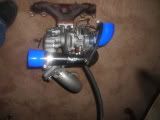I have seen a couple of proyects where people acutally placed the flow meter after the intercooler, and other times more frequently, before the turbo on the inlet side, what are the difernces I can imagine that with less restrictions the turbo will spool up faster than with the meter.
so what i better?
so what i better?






Comment